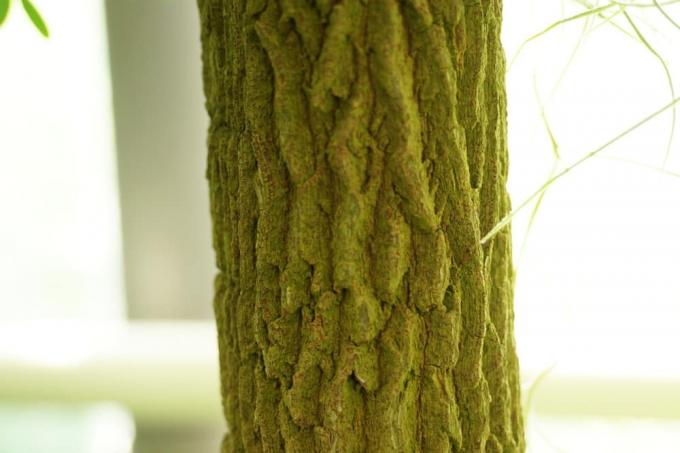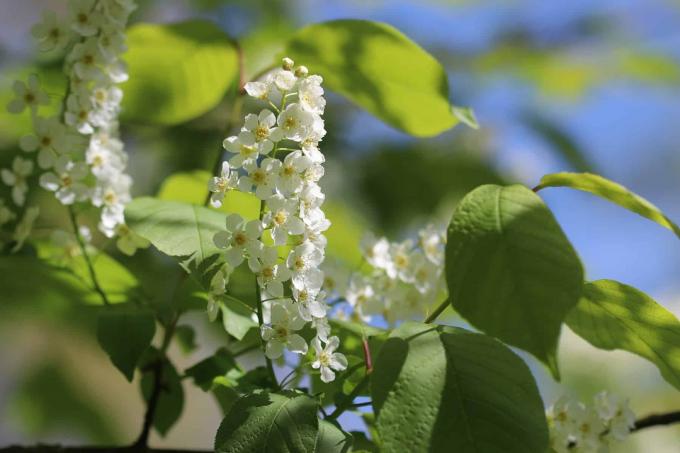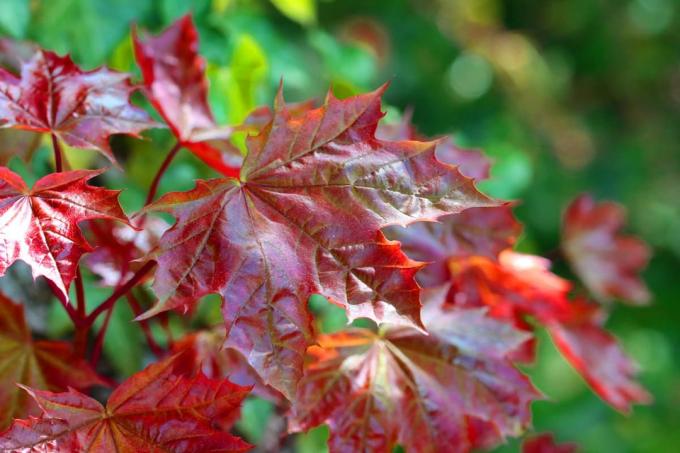

Table of contents
- Location
- substrate
- Pour
- Fertilize
- Cut
- repot
- hibernate
- cultivation
- pretreatment
- planting of the core
- planting of young plants
In the wild, the tamarind tree can grow up to 25 meters tall. Of course, the plant does not reach such heights in our latitudes for climatic reasons alone. As a distinctive container plant, the tree is still impressive. Too bad that Tamarindus indica, as it is called in Latin, can quickly become a major challenge for hobby gardeners. But with the necessary knowledge it works.
Location
Tamarindus indica likes it warm and light. A sunny, light-flooded location is therefore a must. During the growth phase, the plant cannot get enough sunlight. Against this background, it is clear that a winter garden is the ideal location - especially of course, because there is usually also the space that the tree needs. Alternatively, there are also larger rooms in the house directly. However, they should also be in a sunny location and, if possible, have large windows. At temperatures above 15 degrees Celsius, the tamarind can also be placed on the balcony or terrace. Here the plant should also be sheltered from the wind. The following applies: the younger she is, the more protection she needs. By the way, older trees should definitely be outside as long as the temperatures allow it.
A notice:
A location on the windowsill is of course possible, but the space there should quickly become too small. Wherever the sapling is then placed, one should not underestimate the high light requirements of the plant.
substrate
The soil for Tamarindus indica should be as permeable and rich in humus as possible. Older plants may also contain some clay. In principle, high-quality garden soil is perfect for the little tree in the bucket. However, it is important to enrich it with drainage material to ensure reliable water drainage and to prevent waterlogging. Pebbles, shards of pottery or even perlite are the right choice for this.
Pour
The tamarind tree requires relatively little water. One reason for this may be that it grows relatively slowly. However, this does not mean that the soil in which the tree is stuck should dry out completely. Rather, it should always be watered when the surface of the soil in the area of the trunk begins to dry slightly. This guarantees that the all-important root ball is kept constantly moist. On the other hand, this also ensures that no waterlogging forms in or on it. There is therefore no fixed rule as to the rhythm with which the tree should be watered. Rather, it is necessary to check the soil every day and then to water the can if necessary.
Tip:
The water should always be at room temperature. This prevents the relatively sensitive plant from getting something like a cold shock when watering.
Fertilize

Tamarindus indica also needs nutrients to grow and thrive. The substances contained in the soil are no longer sufficient for this very soon. Then there is no way around regular fertilization. It is best to use a complete fertilizer for green plants. Liquid fertilizer is ideal, which you simply pour into the irrigation water. Fertilization time are the months from April to September. In this phase it is necessary to ensure a nutrient supply about every two weeks. Alternatively, you can also work with commercially available fertilizer sticks, which you simply put into the ground. When dosing, the manufacturer's instructions must be observed.
Cut
A cut is not absolutely necessary for the tamarind. It grows so slowly that there is hardly any danger of uncontrollable proliferation. The growth and lushness of this plant can usually not be promoted by regular pruning. Depending on the location, however, it may be necessary to shape the tree somewhat. Then you cannot avoid disturbing branches or to remove shoots. The rule is that the cut may only be made after the hibernation. The cut is about three to five millimeters above a sleeping eye. The cut should be made at a slight angle to allow any water to drain off. Separately, of course, it is necessary to remove diseased branches and deadwood from the trunk.
repot
It can probably not be said often enough: the tamarind tree grows extremely slowly. But even if the progress is not always immediately obvious, it will still increase under the right conditions. As a result, you cannot avoid repotting in a larger planter. Experience has shown that this is necessary about every three years - and only when the bale is fully rooted.
hibernate
Tamarindus indica is neither hardy nor can it do without a rest period. Even temperatures below ten degrees Celsius can be dangerous under certain circumstances. So it is a good thing that the little tree does not necessarily need a special winter quarters. It just can't stay outside if it's spent the summer there. A darkened room is also not necessary. Quite the contrary: this plant also needs a lot of light during the dormant period. In principle, the following requirements should be met during winter storage:
- as bright a location as possible
- Room temperature between 15 and 20 degrees Celsius
- no too dry air (heating)
Against this background, a conservatory is usually something like the perfect refuge for the plant. Unfortunately, it can be relatively dark even there during the winter months. get dark too early. In any case, there is a great danger that the tree will not get enough light, even in an otherwise very sunny location. Therefore, the following applies: the less light is available, the lower the room temperature should be. In general, a temperature of 20 degrees Celsius should not be exceeded. Watering is greatly reduced during the resting phase and fertilization is dispensed with altogether.
cultivation

Most hobby gardeners and plant lovers will get a tamarind tree as a young plant from the garden trade. However, it is also possible to grow your own tamarind. It is best to get ripe tamarind fruits from an Asian shop. Each individual fruit contains four seeds on average. In order to be able to use them, they must first be completely freed from the pulp. That's not always easy. Usually it only helps to suck the seed until the last bit of pulp is gone. It is usually only then that you can tell whether the seeds are even ripe and suitable for germination. If they are dark brown in color, you are usually on the safe side.
pretreatment
However, it is not enough to simply plant the seed in the ground. The seeds of the tamarind have a particularly hard shell, which is supposed to protect against unintentional germination. This germ protection must be removed. Either you rub it very gently with very fine sandpaper, or you soak the seed in warm water for a full day. The latter is of course the much safer option.
planting of the core
Once the germ protection has been removed, the seed can be planted. Coconut substrate is perfect for this. It should be filled in a narrow and relatively high planter. When a fill level of about 75 percent is reached, the seed is placed in the middle and then covered with a thin layer of substrate. This layer should be just thick enough to hide the seed. Everything is then pressed firmly and poured on vigorously. The vessel is then moved to a warm place. After about two to eight weeks, the seed begins to germinate. It forms the first leaves and a taproot.
planting of young plants
As soon as the first leaves appear, the plant needs a lot of light and warmth. The young tamarind should be transplanted from around five pairs of leaves. Garden soil with drainage material is now recommended as a substrate. In addition, a lot of light and heat are still required. However, the vessel must not be placed on the heater, otherwise the entire substrate would dry out very quickly. Rather, the substrate must be kept consistently moist, but must never be wet to avoid waterlogging. Incidentally, a sprayer is ideal for the water supply at this stage. Direct sunlight should be avoided. Fertilization is only necessary for the first time after about two months.
 garden editorial
garden editorial I write about everything that interests me in my garden.
Learn more about Baumlexikon

Bird cherry, Prunus padus: caring for, pruning & propagating
The bird cherry is a shrub or tree that is the ideal bee pasture in a natural garden. However, the plant should also be viewed with caution, as it is a poisonous plant for horses. Nevertheless, it is popular in the local colorful hedges.

Red maple: 9 tips for caring for, cutting & overwintering
The red maple is one of the most impressive trees in Germany due to its unusual scarlet leaf colour. Here you can find out how to integrate this impressive plant into your garden and how to keep it healthy and vigorous.

Sycamore tree: Properly care for and cut sycamore trees
The plane tree (Platanus) has a high decorative value. In terms of care, it is mostly undemanding, which is why it is often chosen as a street tree. Nevertheless, there are a few details to be observed when it comes to care, as described in the home garden guide.

Birch locations: 5 important criteria
Birch trees are extremely frugal trees and are particularly eye-catching and decorative thanks to their light-colored bark. When choosing a location, however, a few factors should be considered in order to create optimal conditions for their growth and to protect the environment.

Cutting dwarf pine - instructions for the perfect cut
Dwarf pines can be pruned by thinning out, topiary or limbing. A bonsai design with needle and root pruning is also possible. So that the wood does not look unattractive after the pruning measure, a few rules of technology should be observed.

Is the vinegar tree poisonous? | Who is it dangerous for?
In ornamental gardens, the vinegar tree is an attractive eye-catcher due to its unusual flowers and the appealing autumn color of its feathered leaves. The red, upright fruit cobs (flowers) are responsible for the striking appearance. Despite everything, the vinegar tree is not an unproblematic tree.



